C语言指针精选习题和答案
C语言指针习题和答案精选文档

C语言指针习题和答案精选文档TTMS system office room 【TTMS16H-TTMS2A-TTMS8Q8-一、用指针方法编写一个程序,输入3个整数,将它们按由小到大的顺序输出#include <>void swap(int *pa,int *pb){int temp;temp = *pa;*pa = *pb;*pb = temp;}void main(){int a,b,c,temp;scanf("%d%d%d",&a,&b,&c);if(a>b)swap(&a,&b);if(b>c)swap(&b,&c);if(a>c)swap(&a,&c);printf("%d,%d,%d",a,b,c);}二、C语言用指针方法输入3个字符串按由小到大顺序输出#include ""#include ""int main(int argc, char* argv[]){char *t;char *p1=NULL,*p2=NULL,*p3=NULL;char ch1[20]={0},ch2[20]={0},ch3[20]={0};p1=ch1;p2=ch2;p3=ch3;printf("No1:");scanf("%s",p1);fflush(stdin);printf("No2:");scanf("%s",p2);fflush(stdin);printf("No3:");scanf("%s",p3);fflush(stdin);if(strcmp(p1,p2)>0){t=p1;p1=p2;p2=t;}if(strcmp(p1,p3)>0){t=p1;p1=p3;p3=t;}if(strcmp(p2,p3)>0){t=p2;p2=p3;p3=t;}printf("%s\n%s\n%s\n",p1,p2,p3);return 0;}编程输入一行文字,找出其中的大写字母,小写字母,空格,数字,及其他字符的个数#include<>void main(){int a=0,b=0,c=0,d=0,e=0,i=0;char *p,s[20];while((s[i]=getchar())!='\n')i++;p=s;while(*p!=10){if(*p>='A'&&*p<='Z')a++;else if(*p>='a'&&*p<='z')b++;else if(*p==' ')c++;else if(*p>='0'&&*p<='9')d++;else e++;p++;}printf("大写字母 %d 小写字母 %d\n",a,b);printf("空格 %d 数字 %d 非字符 %d\n",c,d,e);}写一个函数,将3 3矩阵转置#include ""void Transpose(int (*matrix)[3]){int temp;int i, j;for(i=1;i<3;i++)/*转置*/{for(j=0;j<i;j++){temp = *(*(matrix+j)+i);*(*(matrix+j)+i) = *(*(matrix+i)+j); *(*(matrix+i)+j) = temp;}}}void main(){int a[3][3] = {{1,2,3},{4,5,6},{7,8,9}}; Transpose(a);for(int i = 0;i<3;i++){for(int j=0;j<3;j++){printf("%d ",a[i][j]);}printf("\n");}}}用指向一维数组的指针做函数参数#include<>#include<>int main(){void sort(char (*s)[6]);3”n",*(month_name+n));elseprintf("It is wrong.\n");}运行结果:① Input month: 2↙It is February.② Input month: 8↙It is August.③ Input month: 13↙It is wrong.9.11c语言:将字符串computer赋给一个字符数组,然后从第一个字母开始间隔地输出该串。
c语言指针试题

c语言指针试题
以下是一些关于C语言指针的试题,供您参考:
1.什么是指针?指针在C语言中的作用是什么?
2.指针变量如何声明和初始化?
3.指针运算符有哪些?它们的作用是什么?
4.指针如何进行算术运算和关系运算?
5.什么是空指针?如何声明和使用空指针?
6.指针如何进行类型转换?有哪些类型转换需要注意?
7.什么是函数指针?如何声明和使用函数指针?
8.什么是数组指针?如何声明和使用数组指针?
9.指针如何用于动态内存分配?有哪些常见的动态内存分配函数?
10.指针在使用中需要注意哪些问题?如何避免常见的指针错误?。
c语言指针的习题答案

指针练习题1.有以下程序main(){char a[]="programming",b[]="language";char *p1,*p2;int i;p1=a;p2=b;for(i=0;i<7;i++)if(*(p1+i)==*(p2+i))printf("%c",*(p1+i));}输出结果是A)gm B)rg C)or D)ga2.设有说明int(*ptr)[m];其中的标识符ptr是A)M个指向整型变量的指针B)指向M个整型变量的函数指针C)一个指向具有M个整型元素的一维数组的指针D)具有M个指针元素的一维指针数组,每个元素都只能指向整型量3.若已定义:int a[9],*p=a;并在以后的语句中未改变p的值,不能表示a[1] 地址的表达式是A) p+1 B) a+1 C) a++ D) ++p4.若有语句int *point ,a=4;和point =&a;下面均代表地址的一组选项是A. a,point,*&aB. &*a,&a,*pointC. &point,*point,&aD. &a,&*point,point5.下面程序段的运行结果是char a[]=”language”,*p;p=a;while(*p!=’u’) {printf(“%c”, *p-32);p++;}A. LANGUAGEB. LANGuageNGngUAGE6.以下程序的运算结果是*p=1,m=3,n=5 。
#include<stdio.h>void main(){int a[5]={1,2,3,-4,5};int m,n,*p;p=&a[0];m=*(p+2);n=*(p+4);printf("*p=%d,m=%d,n=%d",*p,m,n);}7.写一通用函数slength,求出一个字符串的长度,并用main函数调用slength。
指针测试题及答案大全

指针测试题及答案大全一、选择题1. 指针变量的声明方式正确的是()。
A. int *p;B. int *p[];C. int *p[10];D. int (*p)[10];答案:A2. 指针变量可以存储()。
A. 整型数据B. 浮点型数据C. 函数名D. 任意类型的地址答案:D3. 指针变量的值是()。
A. 它所指向的变量的值B. 它所指向的变量的地址C. 它自己的值D. 它自己的地址答案:B4. 指针变量的类型转换时,以下说法正确的是()。
A. 可以将任何类型的指针转换为void指针B. 可以将void指针转换为任何类型的指针C. 可以将char指针转换为int指针D. 可以将int指针转换为char指针答案:A5. 指针变量的算术运算中,以下说法正确的是()。
A. 指针变量可以进行加法运算B. 指针变量可以进行减法运算C. 指针变量可以进行乘法运算D. 指针变量可以进行除法运算答案:B二、填空题1. 指针变量的值是它所指向的变量的________。
答案:地址2. 指针变量的类型转换时,可以将void指针转换为________类型的指针。
答案:任何类型3. 指针变量的算术运算中,指针变量可以进行________运算。
答案:减法三、简答题1. 描述指针变量与数组之间的关系。
答案:指针变量可以指向数组的首元素,从而可以通过指针访问数组中的所有元素。
数组名在大多数情况下可以作为指向数组首元素的指针使用。
2. 解释指针变量的类型转换规则。
答案:指针变量的类型转换遵循C语言的类型转换规则,可以将任何类型的指针转换为void指针,也可以将void指针转换为任何类型的指针。
但是,不同类型的指针之间不能直接转换,除非它们指向的数据类型是兼容的。
结束语:以上是指针测试题及答案大全,希望对您的学习有所帮助。
c语言指针问题及答案
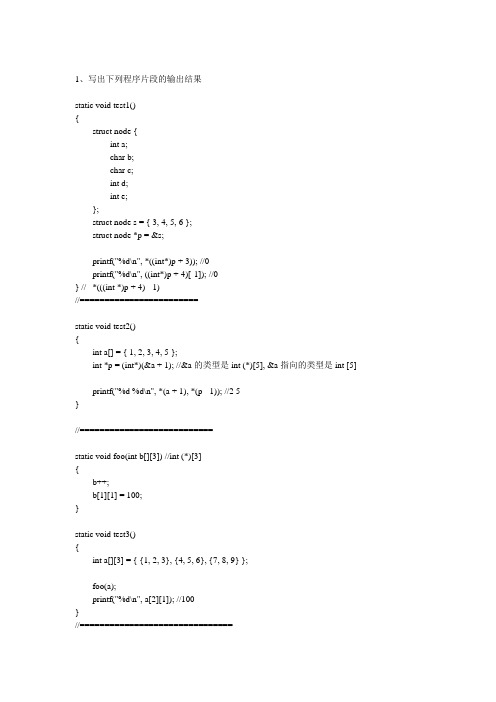
}
static void foo2(int *p, int *q){
int *tmp = p;p = q;q = tmp;
}
static void test5()
{
int a = 3;int b = 5;
void (*p[2])(int*, int*);
void(*p[2])(int *, int);
定义了一个函数指针的数组p, p有两个指针元素.元素是函数的指针,函数指针指向的函数是一个带2个参数,不返回任何类型值的函数,所带的两个参数分别是指向整型的指针,和整型
p[0] = f1; p[1] = f2 contain address of function .function name without parenthesis represent address of function Value and address of variable is passed to function only argument that is effected is a (address is passed). Because of call by value f1, f2 can not effect b
int (*p)[3] = a;
printf("%d %d\n", (*p)[1], (*p)[2]);
//*(*p + 1) //2 3
p++;
printf("%d %d\n", (*p)[1], (*p)[2]); //5 6
}
//==============================
c语言指针题目及答案

c语言指针题目及答案一选择题(7分,每小题0.5分)1.C语言源程序的基本单位是( )。
A 过程B 函数C 子程序D 标识符2.下列程序的输出结果是( )。
main( ){ int a=7,b=5;printf("%d",b=b/a);}A 5B 1C 0 D不确认值3.假设变量a,b均为整型,表达式(a=5,b=2,a>b?a++:b++,a+b)的值是( )。
A 7B 8C 9D 24.设a为int型变量,执行下列赋值语句后,a的取值分别是( )。
a=125.534; a=(int)125.521%4; a=5<<2;A 125,31,1B 125,1,20C 125,31,20D 125.534,2,205.建有如下程序段,下面叙述中恰当的就是 ( )。
int k=10; while(k=0) k=k-1;A 循环继续执行一次 B循环就是无穷循环 C循环体语句一次也不继续执行 D循环体语句继续执行一次6.以下程序的输出结果为( )。
int i;void prt( ){ for(i=5;i<8;i++) printf("%c",'*');printf(" ");}main( ){ for(i=5;i<=8;i++) prt( );}A ***B *** *** *** ***C *** ***D * * *7.在C语言程序中,以下说法正确的是( )。
A函数的定义可以嵌套,但函数的调用不可以嵌套B函数的定义不可以嵌套,但函数的调用可以嵌套C函数的定义和函数的调用都不可以嵌套D函数的定义和函数的调用都可以嵌套8.以下函数调用语句中所含( )个实参。
func((e1,e2),(e3,e4,e5));A 2B 3C 5D 语法错误9.以下程序的输出结果为( )。
#define ADD(x) x*xmain( ){ int a=4,b=6,c=7,d=ADD(a+b)*c;printf("d=%d",d);}A d=70B d=80C d=140D d=70010.未知职工记录叙述如下,在Turbo C中,系统为变量w分配( )字节的空间。
C语言指针精选习题和答案

C语言指针精选习题和答案一、用指针方法编写一个程序,输入3个整数,将它们按由小到大的顺序输出#include <stdio.h>void swap(int *pa,int *pb) {int temp;temp = *pa;*pa = *pb;*pb = temp;}void main(){int a,b,c,temp;scanf("%d%d%d",&a,&b,&c); if(a>b)swap(&a,&b);if(b>c)swap(&b,&c);if(a>c)swap(&a,&c);printf("%d,%d,%d",a,b,c); }二、C语言用指针方法输入3个字符串按由小到大顺序输出#include "stdio.h"#include "string.h"int main(int argc, char* argv[]){char *t;char *p1=NULL,*p2=NULL,*p3=NULL;char ch1[20]={0},ch2[20]={0},ch3[20]={0}; p1=ch1;p2=ch2;p3=ch3;printf("No1:");scanf("%s",p1);fflush(stdin);printf("No2:");scanf("%s",p2);fflush(stdin);printf("No3:");scanf("%s",p3);fflush(stdin);if(strcmp(p1,p2)>0){t=p1;p1=p2;p2=t;}if(strcmp(p1,p3)>0){t=p1;p1=p3;p3=t;}if(strcmp(p2,p3)>0){t=p2;p2=p3;p3=t;}printf("%s\n%s\n%s\n",p1,p2,p3);return 0;}9.4编程输入一行文字,找出其中的大写字母,小写字母,空格,数字,及其他字符的个数#include<stdio.h>void main(){int a=0,b=0,c=0,d=0,e=0,i=0; char *p,s[20];while((s[i]=getchar())!='\n')i++; p=s;while(*p!=10){if(*p>='A'&&*p<='Z') a++;else if(*p>='a'&&*p<='z') b++;else if(*p==' ')c++;else if(*p>='0'&&*p<='9') d++;else e++;p++;}printf("大写字母 %d 小写字母 %d\n",a,b); printf("空格 %d 数字 %d 非字符 %d\n",c,d,e); }9.5写一个函数,将3 3矩阵转置 #include "stdio.h"void Transpose(int (*matrix)[3]) {int temp;int i, j;for(i=1;i<3;i++)/*转置*/{for(j=0;j<i;j++){temp = *(*(matrix+j)+i);*(*(matrix+j)+i) = *(*(matrix+i)+j);*(*(matrix+i)+j) = temp;}}}void main(){int a[3][3] = {{1,2,3},{4,5,6},{7,8,9}}; Transpose(a);for(int i = 0;i<3;i++){for(int j=0;j<3;j++){printf("%d ",a[i][j]);}printf("\n");}}}9.6用指向一维数组的指针做函数参数 #include<stdio.h>#include<string.h>int main(){void sort(char (*s)[6]);//一维数组的指针做函数参数int i;char str[10][6];char (*p)[6];//定义一维数组的指针做函数参数printf("please input string:/n");for(i=0;i<10;i++)scanf("%s",&str[i]);p=str;//将str一维数组指针,赋值给p;sort(p);printf("the output sequence :/n");for(i=0;i<10;i++)printf("%s/n",str[i]);return 0;}void sort(char (*s)[6])//s指向一维数组的指针做函数参数; {int i,j;char temp[6], *t;t=temp;for(i=0;i<9;i++)//i应该小于9;如果小于10,那么就比较了9+1次;按照冒泡法则,for(j=0;j<9-i;j++)//第一次比较需要9次就是i=0到i=8共九次;第二次需要比较8次;依次类推;if(strcmp(s[j],s[j+1])>0){strcpy(t,s[j]);strcpy(s[j],s[j+1]);strcpy(s[j+1],t);}}9.7编一程序,用指针数组在主函数中输入十个等长的字符串。
(完整word版)C语言指针练习+答案+讲解

第七章指针7.1 选择题1.若有说明:int a=2, *p=&a, *q=p;,则以下非法的赋值语句是(D)。
A. p=q; B. *p=*q; C. a=*q; D. q=a;a是整型数,int *p,*q定义了指针,p,q是指向整型的指针.p取得a的地址,而q取得p的地址p,q是指针(也就是一个地址),而*p和*q是这个指针指向的整型数值(存放在这个地址的值).A)把q的地址赋给p,则p和q完全一样了,都指向一个数2B)把q中数据个pC)把q中数据给aD)a中数据是2,不能够给一个地址。
除非*q=a2.若定义:int a=511, *b=&a;,则printf("%d\n”, *b);的输出结果为:D A.无确定值 B. a的地址 C. 512 D. 511int a=511,*b=&a;a 是整形变量b 是整形指针变量,指向 aprintf("%d\n",*b);就是输出指针变量 b,所指变量的值输出结果5113.已有定义int a=2, *p1=&a, *p2=&a; 下面不能正确执行的赋值语句是(B)。
A. a=*p1+*p2; B. p1=a; C. p1=p2; D. a=*p1*(*p2);47、已知在程序中定义了如下的语句:int *P1,*P2;int k;p1=&k;p2=&k;则下列语句中不能正确执行是( B )A、k=*P1+*P2;B、p2=k;C、P1=P2;D、K=*P1 * (*P2);P1 P2是指针,K是整型变量,变量怎么可以赋值给指针呢?A其实是执行了K=K+K(P1和P2都指向K,所以*P1 *P2其实都是指K)C是赋值语句D其实执行了K=K*K4.变量的指针,其含义是指该变量的(B)。
A.值 B.地址 C.名 D.一个标志5.若有说明语句:int a, b, c, *d=&c;,则能正确从键盘读入三个整数分别赋给变量a、b、c的语句是(A)。
c语言指针指针变量scanf,C语言指针练习(包括答案和详解)

c语⾔指针指针变量scanf,C语⾔指针练习(包括答案和详解)《C语⾔指针练习(包括答案和详解)》由会员分享,可在线阅读,更多相关《C语⾔指针练习(包括答案和详解)(21页珍藏版)》请在⼈⼈⽂库⽹上搜索。
1、第7章第7章指针71选择题1说明:int a=2,*p=,以下错误的赋值语句为(D):a p=q;b * p=* q;c a=* q;d q=a;a是整数,int*p,*q定义指针,p,q是指向整数的指针。
p获取a的地址,q获取p的地址p。
q是指针(即地址),*p和*q是此指针指向的整数值(此地址中存储的值)。
a)如果将q的地址分配给p,则p和q完全相同。
都指向数字2 B。
)q的数据个p C) q的数据为a D)a的数据为2。
⽆法提供地址。
如果未定义*q=a 2,则:int a=511,*b=的输出为:D A未确定的值B a的地址C 512D 511 int a=511,*b=a是a pri。
2、ntf(输出指针变量B)。
也就是说,指向变量的值输出结果511 3中已经有int a=2,*p1=下未正确执⾏的赋值语句为(b)。
Aa=* p1 *p2bp1=a;Cp1=p2da=* P1 *(* p2);据悉,程序中定义了以下语句:int *P1,* P2int k;P1=p2=⽆法在以下语句中正确执⾏是(B) A,k=* P1 * P2b,p2=k;c,P1=P2d,K=* P1 *(* P2);P1 P2是指针,K是整数变量,变量如何为指针赋值?a实际上是k=k k k (P1和P2都指向K,因此*P1*P2实际上是K) C是赋值语句d实际执⾏K=K*K 4变量的指针。
含义是变量(b。
3、)。
a值b地址c名称d标志5如果有说明语句:int a、b、c、* d=b scanf (%d% d% d、a、b、d);C scanf (%d% d% d,d scanf (%d% d% d,a,b,* d);对于Int c,* d=,c是整数数据,d是指向变量c的指针。
2021年C语言考试指针知识习题及答案(精选)

void main() {
int a=25;prtv(&a);
·4·
} 9、以下程序的输出结果是(B)。 A、运行出错 B、100 C、a 的地址 D、b 的地址 #include<stdio.h> void main() { int **k,*a,b=100; a=&b;k=&a; printf(“%d\n”,**k); } 10、以下程序运行后,输出结果是(D)。 A) 8 B) 7 C) 6 D) 5 #include<stdio,h> ss(char *s) { char *p=s; while(*p) p++; return(p-s);
·1·
2021 年 C 语言考试指针知识习题及答案(精选)
1 选择题 1、若有定义:int x,*pb;则以下正确的表达式是(A) A、pb=&x B、pb=x C、*pb=&x D、*pb=*x 2、以下程序的输出结果是(B) A、因变量无定义输出不定值 B、0 C、-1 D、1 #include<stdio.h> void main() {printf(“%d\n”,NULL);} 3、以下程序的输出结果是(B) A、5,2,3 B、-5,-12,-7 C、-5,-12,-17 D、5,-2,-7 #include<stdio.h> void sub(int x,int y,int *z) {*z=y-x;} void main() { int a,b,c;
·2·
sub(10,5,&a); sub(7,a,&b); sub(a,b,&c);
printf(“%d,%d,%d\n”,a,b,c);
【C语言指针模拟测试题_答案】
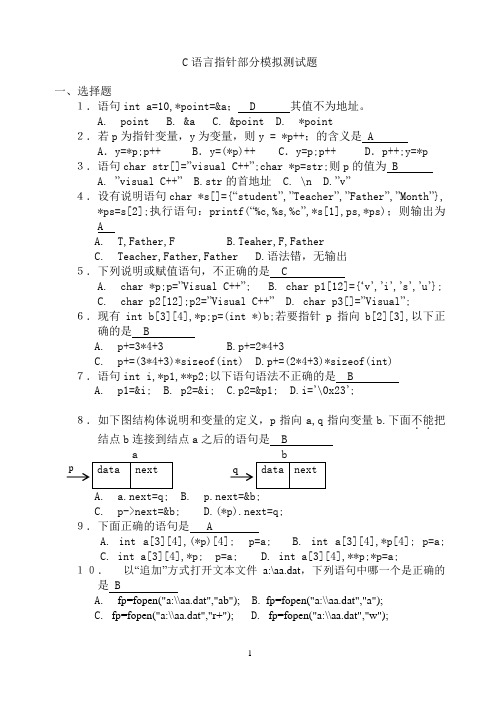
C语言指针部分模拟测试题一、选择题1.语句int a=10,*point=&a; D 其值不为地址。
A. pointB. &aC. &pointD. *point2.若p为指针变量,y为变量,则y = *p++;的含义是 A A.y=*p;p++ B.y=(*p)++ C.y=p;p++ D.p++;y=*p 3.语句char str[]=”visual C++”;char *p=str;则p的值为 BA. ”visual C++”B.str的首地址C. \nD.”v”4.设有说明语句char *s[]={“student”,”Teacher”,”Father”,”Month”}, *ps=s[2];执行语句:printf(“%c,%s,%c”,*s[1],ps,*ps);则输出为AA.T,Father,FB.Teaher,F,FatherC. Teacher,Father,FatherD.语法错,无输出5.下列说明或赋值语句,不正确的是 CA. char *p;p=”Visual C++”;B. char p1[12]={‘v’,’i’,’s’,’u’};C. char p2[12];p2=”Visual C++”D. char p3[]=”Visual”;6.现有int b[3][4],*p;p=(int *)b;若要指针p指向b[2][3],以下正确的是 BA.p+=3*4+3B.p+=2*4+3C. p+=(3*4+3)*sizeof(int)D.p+=(2*4+3)*sizeof(int)7.语句int i,*p1,**p2;以下语句语法不正确的是 BA.p1=&i;B. p2=&i;C.p2=&p1;D.i=’\0x23’;8.如下图结构体说明和变量的定义,p指向a,q指向变量b.下面不能..把结点b连接到结点a之后的语句是 BC. p->next=&b;D.(*p).next=q;9.下面正确的语句是 AA. int a[3][4],(*p)[4]; p=a;B. int a[3][4],*p[4]; p=a;C. int a[3][4],*p; p=a;D. int a[3][4],**p;*p=a;10.以“追加”方式打开文本文件a:\aa.dat,下列语句中哪一个是正确的是 BA.fp=fopen("a:\\aa.dat","ab");B. fp=fopen("a:\\aa.dat","a");C. fp=fopen("a:\\aa.dat","r+");D. fp=fopen("a:\\aa.dat","w");11.设有函数定义:int f1(void){return 100,150;}调用函数f1()时, BA.函数返回值100B. 函数返回值150C. 函数返回二个值100和150D. 语句return 100,150;语法错.12.数组作为函数的形参时,把数组名作为实参,传递给函数的是 AA.该数组的首地址B. 该数组的元素个数C. 该数组中的各元素值D. 该数组的大小13.执行以下语句序列:则 Aenum {Sun,Mon,Tue,Wed,Thu,Fri,Sat}c1,c2; //Ac1=Mon; //Bprintf(“%d”,c1);A.输出1B.输出2C.输出0D. B行语法错14.执行以下语句序列:则 Cchar *p1=”Speaking”; //Achar *p2=”English”; //Bchar *p3=”a piece of cake”; //Cchar *str[]={p1,p2,p3}; //Dprintf(“%c”,*(str[0]+1));A.输出EnglishB.输出SpeakingC.输出pD. D行语法错二、填空题1.(2*2分=4分)下面程序的运行结果为16 、 2void main( ){static int a[3][2]={{12},{14,16},{1,2}};int *p=a[1];printf(“%d\n”,*(p+1));printf(“%d\n”,*(p+3));}2.(2*2分=4分)若有以下程序段,则*(*(b+2)+1)的值为11 ,*(*(p+1)+1)的值为7static int b[3][2]={1,3,5,7,9,11};int (*p)[2];p=b;3.(1*4分=4分)下面程序的运行结果为26#include<stdio.h>void sub(int *x,int i,int n){if(n<=i)sub(x,i,3*n);*x+=n++;}void main( ){int x=0;sub(&x,12,2);printf(“%d”,x);}4.(2*2分=4分)以下程序运行结果为_ Hello,world _、ello,world void main(){char *p,*q;char str[]="Hello,World\n";q = p = str;p++;printf(“%s\n”,q);printf(“%s\n”,p);}5. (1*4分=4分)以下程序运行结果是__121232343454_________ void main(){short ar[5]={1,2,3,4,5 };short * par=&ar[1];int i;for(i=0; i<4; i++){printf(“%d %d %d”,ar[i],par[i],*(ar+i));}}6.(2*2分=4分) 以下程序运行结果是__200 100_____void swap2(int *x,int *y){int t;t=*x;*x=*y;*y=t;}void main( ){ int a=100,b=200;swap2(&a,&b);printf(“%d\t%d”,a,b);}7.(3*2分=6分)void fun(int n, int *s){ int f1,f2;if(n= =1||n= =2)*s=1;else{fun(n-1,&f1);fun(n-2,&f2);*s=2*f1+f2+1;printf(“%d\t%d”,f1,f2);}}void main( ){ int x;fun(4,&x);printf(”x=%d\n”,x);}程序输出的第一行是1 1 第二行是4 1 最后一行是x=108. (3*2分=6分)void f(int *q1,int *q2,int *q3){*q3=*q1+*q2;}void main( ){ int i,j,a[3][3]={1,1},*p1=a[0],*p2=a[0]+1,*p3=a[0]+2;for(i=2;i<9;i++)f(p1++,p2++,p3++);for(i=0;i<3;i++){ for(j=0;j<3;j++)printf(“%d”,a[i][i]);printf(’\n’);}}程序输出的第一行是111 第二行是555 最后一行是343434 9.(2*3分=6分)int f(int x,int y){return x*y;}void main( ){ int i,j,(*fun)(int,int);fun=f;for(i=1;i<4;i++){ switch(i){case 1:case 2: j=(*fun)(i,i+1);break;case 3: j=(*fun)(i-1,i+2);break;}printf(”j=%d”,j);}}程序输出的第一行是j=2 第二行是j=6 最后一行是j=10三、完善程序1.(2*3分=6分)以下min 函数的功能是:在非空单向链表中查找结点数据域为最小的值,并作为函数返回值.链表如下.struct NODE{int data;NODE *next;};int min(NODE *first){NODE *p;int m;p=first;m=p->data;for(p=p->next;p!=NULL;p= p->next )if(m> p->data )m=p->data;return m;}2.(3*2分=6分)以下程序求二维数组的平均值float average(float (*p)[4],int n){float sum=0;for(int i=0; i<n ;i++){for(j=0;j<4;j++)sum+= (*p)[j] 或 *(*p+j) ;p++;}return sum/(n*4);}void main( ){ float score[3][4]={{56,65,70,76},{89,97,52,81},{90,99,91,86}};printf(”平均值=%f ”,average(score, 3 ));}3. (2*3.5分=7分)以下程序实现将以L 为头指针的链表逆置(设结点个数n>2),即将链表头当链表尾,链表尾当链表头。
C语言指针练习题

C语言指针练习题指针练习题1 填空题【1】下面函数要求用来求出两个整数之和,并通过形参传回两数相加之和值,请填空。
int add( int x, int y, ){ =x+y;}【2】若有定义: char ch;(1) 使指针p 可以指向变量ch的定义语句是。
(2) 使指针p指向变量ch的赋值语句是。
(3) 通过指针p给变量ch读入字符的scanf函数调用语句是。
(4) 通过指针p 给变量ch赋字符A的语句是。
(5) 通过指针p输出ch中字符的语句是。
(6) 在16位微机上,指针变量p在内存中所占字节数是,变量ch 在内在所占字节数是。
2 选择题【3】若有说明:int i,j=7,*p=&i则与i=j;等价的语句是()。
A.i=*p;B.*p=*&jC.i=&jD.i=**p;【4】若有定义:int x,*pb;则正确的赋值表达式是()。
A.pb=&xB.pb=xC. *pb=&xD.*pb=*x【5】对于类型相同的指针变量,不能进行的运算是()。
A.< B. = C. + D. –【6】以下程序的输出结果是()。
A.23 B. 24 C. 25 D. 26Void fun ( int *x){ printf(%d\n”,++*x); }main( ){ int a=25;fun (&a);}【7】以下程序的输出结果是()。
A.6 B. 7 C. 8 D. 9main(){int k=2,m=4,n=6;int *pk=&k,*pm=&m,*p;*(p=&n)=*pk*(*pm);printf("%d\n",n);}【8】以下程序的输出结果是()。
A.100 B. 50 C. 101 D.200main(){int *v,b;v=&bb=100;*v+=b;printf("%d\n",b);}【9】以下程序的输出结果是()。
C语言程序设计指针作业

C语言程序设计指针作业一、选择题【习题1】变量的指针,其含义是指该变量的________A)值B)地址C)名D)一个标志【习题2】若有语句int *point,a; 则point=&a;中运算符&的含义是_____A)位与运算B)逻辑与运算C)取指针内容D)取地址【习题3】若x是整型变量,pb是整型的指针变量,则正确的赋值表达式是A) pb=&x B) pb=x; C) *pb=&x; D) *pb=*x【习题4】下面程序段的运行结果是_________char *s="abcde";s+=2;printf("%d",s);A)cde B)字符’c’C)字符’c’的地址D)无确定的输出结果【习题5】设p1和p2是指向同一个字符串的指针变量,c为字符变量,则以下不能正确执行的赋值语句是______A)c=*p1+*p2; B)p2=c C)p1=p2 D)c=*p1*(*p2);【习题6】若有定义语句char a[]="It is mine";char *p="It is mine";则以下不正确的叙述是________.A)a+1表示的是字符t的地址B)p指向另外的字符串时,字符串的长度不受限制C)p变量中存放的地址值可以改变D)a中只能存放10个字符【习题7】若有定义:int a[2][3],则对a数组的第i行j列元素地址的正确引用为___A)*(a[i]+j) B)(a+i) C)*(a+j) D)a[i]+j【习题8】设有如下定义:int (*ptr)( );则以下叙述中正确的是:A)ptr是指向一维组数的指针变量B)ptr是指向int型数据的指针变量C)ptr是指向函数的指针,该函数返回一个int型数据D)ptr是一个函数名,该函数的返回值是指向int型数据的指针【习题9】设有定义int (*ptr)[m];其中的标识符ptr是A)m个指向整型变量的指针B)指向m个整型变量的函数指针C)一个指向具有m个整型元素的一维数组的指针D)具有m个指针元素的一维指针数组,每个元素都只能指向整型量【习题10】若要用下面的程序片段使指针变量p指向一个存储整型变量的动态存储单元:int *p;p=__________ malloc( sizeof(int));则应填入A) int B) int * C) (*int) D) (int *)二、阅读下列程序,填空或给出程序运行结果。
C语言指针习题__附答案[1]
![C语言指针习题__附答案[1]](https://img.taocdn.com/s3/m/344613ced05abe23482fb4daa58da0116c171f8c.png)
一、选择题1.变量的指针,其含义是指该变量的_________.a)值b)地址c)名d)一个标志2.若有语句int *point,a=4;和point=&a;下面均代表地址的一组选项是_____. a)a,point,*&a b)&*a,&a,*pointc)*&point,*point,&a d)&a,&*point ,point3.若有说明;int *p,m=5,n;以下正确的程序段的是________.a)p=&n; b)p=&n;scanf("%d",&p); scanf("%d",*p);c)scanf("%d",&n); d)p=&n;*p=n; *p=m;4. 以下程序中调用scanf函数给变量a输入数值的方法是错误的,其错误原因是________.main(){int *p,*q,a,b;p=&a;printf(“input a:”);scanf(“%d”,*p);……}a)*p表示的是指针变量p的地址b)*p表示的是变量a的值,而不是变量a的地址c)*p表示的是指针变量p的值d)*p只能用来说明p是一个指针变量5. 已有变量定义和函数调用语句:int a=25; print_value(&a); 下面函数的正确输出结果是________.void print_value(int *x){ printf(“%d\n”,++*x);}a)23 b)24 c)25 d)266.若有说明:long *p,a;则不能通过scanf语句正确给输入项读入数据的程序段是A) *p=&a;scanf("%ld",p);B) p=(long *)malloc(8);scanf("%ld",p);C) scanf("%ld",p=&a);D) scanf("%ld",&a);7.有以下程序#include<stdio.h>main(){ int m=1,n=2,*p=&m,*q=&n,*r;r=p;p=q;q=r;printf("%d,%d,%d,%d\n",m,n,*p,*q);}程序运行后的输出结果是A)1,2,1,2 B)1,2,2,1C)2,1,2,1 D)2,1,1,28.有以下程序main(){ int a=1, b=3, c=5;int *p1=&a, *p2=&b, *p=&c;*p =*p1*(*p2);printf("%d\n",c);}执行后的输出结果是A)1 B)2 C)3 D)49. 有以下程序main(){ int a,k=4,m=4,*p1=&k,*p2=&m;a=p1==&m;printf("%d\n",a);}程序运行后的输出结果是()A)4 B)1 C)0 D)运行时出错,无定值10. 在16位编译系统上,若有定义int a[]={10,20,30}, *p=&a;,当执行p++;后,下列说法错误的是()A)p向高地址移了一个字节B)p向高地址移了一个存储单元C)p向高地址移了两个字节D)p与a+1等价11.有以下程序段int a[10]={1,2,3,4,5,6,7,8,9,10},*p=&a[3],b;b=p[5];b中的值是()A)5 B)6 C)8 D)912.若有以下定义,则对a数组元素的正确引用是_________.int a[5],*p=a;a)*&a[5] b)a+2 c)*(p+5) d)*(a+2)13.若有以下定义,则p+5表示_______.int a[10],*p=a;a)元素a[5]的地址b)元素a[5]的值c)元素a[6]的地址d)元素a[6]的值14.设已有定义: int a[10]={15,12,7,31,47,20,16,28,13,19},*p; 下列语句中正确的是()A) for(p=a;a<(p+10);a++);B) for(p=a;p<(a+10);p++);C) for(p=a,a=a+10;p<a;p++);D) for(p=a;a<p+10; ++a);15.有以下程序段#include <stdio.h>int main(){ int x[] = {10, 20, 30};int *px = x;printf("%d,", ++*px); printf("%d,", *px);px = x;printf("%d,", (*px)++); printf("%d,", *px);px = x;printf("%d,", *px++); printf("%d,", *px);px = x;printf("%d,", *++px); printf("%d\n", *px);return 0;}程序运行后的输出结果是( )A)11,11,11,12,12,20,20,20 B)20,10,11,10,11,10,11,10C)11,11,11,12,12,13,20,20 D)20,10,11,20,11,12,20,2016.设有如下定义:int arr[]={6,7,8,9,10};int *ptr;ptr=arr;*(ptr+2)+=2;printf ("%d,%d\n",*ptr,*(ptr+2));则程序段的输出结果为A)8,10 B)6,8 C)7,9 D)6,1017.若有定义:int a[]={2,4,6,8,10,12},*p=a;则*(p+1)的值是______. *(a+5)的值是_________.18.若有以下说明和语句,int c[4][5],(*p)[5];p=c;能正确引用c数组元素的是______.A) p+1 B) *(p+3) C) *(p+1)+3 D) *(p[0]+2))19.若有定义:int a[2][3],则对a数组的第i行j列元素地址的正确引用为______.a)*(a[i]+j) b)(a+i) c)*(a+j) d)a[i]+j20.若有以下定义:int a[2][3]={2,4,6,8,10,12};则a[1][0]的值是_____. *(*(a+1)+0)的值是________.21.有以下定义char a[10],*b=a;不能给数组a输入字符串的语句是()A)gets(a) B)gets(a[0]) C)gets(&a[0]); D)gets(b);22.下面程序段的运行结果是_________.char *s="abcde";s+=2;printf("%d",s);a)cde b)字符'c' c)字符'c'的地址d)无确定的输出结果23.以下程序段中,不能正确赋字符串(编译时系统会提示错误)的是()A) char s[10]="abcdefg"; B) char t[]="abcdefg",*s=t;C) char s[10];s="abcdefg"; D) char s[10];strcpy(s,"abcdefg");24.设已有定义: char *st="how are you"; 下列程序段中正确的是()A) char a[11], *p; strcpy(p=a+1,&st[4]);B) char a[11]; strcpy(++a, st);C) char a[11]; strcpy(a, st);D) char a[], *p; strcpy(p=&a[1],st+2);25.有以下程序main(){char a[]="programming",b[]="language";char *p1,*p2;int i;p1=a;p2=b;for(i=0;i<7;i++)if(*(p1+i)==*(p2+i))printf("%c",*(p1+i));}输出结果是()A)gm B)rg C)or D)ga26.设p1和p2是指向同一个字符串的指针变量,c为字符变量,则以下不能正确执行的赋值语句是________.a)c=*p1+*p2; b)p2=c c)p1=p2 d)c=*p1*(*p2);27.以下正确的程序段是_________.a)char str[20]; b)char *p;scanf("%s",&str); scanf("%s",p);c)char str[20]; d)char str[20],*p=str;scanf("%s",&str[2]); scanf("%s",p[2]);28.若有说明语句char a[]="It is mine";char *p="It is mine";则以下不正确的叙述是________.a)a+1表示的是字符t的地址b)p指向另外的字符串时,字符串的长度不受限制c)p变量中存放的地址值可以改变d)a中只能存放10个字符29.下面程序的运行结果是_______.#include <stdio.h>#include <string.h>main(){ char *s1="AbDeG";char *s2="AbdEg";s1+=2;s2+=2;printf("%d\n",strcmp(s1,s2));}a)正数b)负数c)零d)不确定的值30.有以下程序void f(int *x,int *y){int t;t=*x;*x=*y;*y=t;}main(){int a[8]={1,2,3,4,5,6,7,8},i,*p,*q;p=a;q=&a[7];while(*p!=*q){f(p,q);p++;q--;}for(i=0;i<8;i++) printf("%d,",a[i]);}程序运行后的输出结果是______。
指针练习题及答案
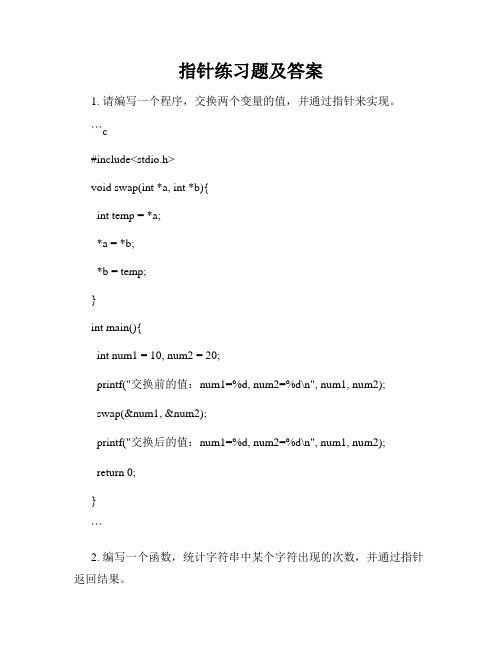
指针练习题及答案1. 请编写一个程序,交换两个变量的值,并通过指针来实现。
```c#include<stdio.h>void swap(int *a, int *b){int temp = *a;*a = *b;*b = temp;}int main(){int num1 = 10, num2 = 20;printf("交换前的值:num1=%d, num2=%d\n", num1, num2);swap(&num1, &num2);printf("交换后的值:num1=%d, num2=%d\n", num1, num2);return 0;}```2. 编写一个函数,统计字符串中某个字符出现的次数,并通过指针返回结果。
```c#include<stdio.h>int countChar(const char *str, char target){int count = 0;while(*str != '\0'){if(*str == target)count++;str++;}return count;}int main(){char str[] = "hello world";char target = 'l';int count = countChar(str, target);printf("字符 %c 出现的次数为:%d\n", target, count); return 0;}```3. 编写一个函数,找到整型数组中的最大值,并通过指针返回结果。
```c#include<stdio.h>int findMax(const int *arr, int size){int max = *arr;for(int i = 1; i < size; i++){if(*(arr+i) > max)max = *(arr+i);}return max;}int main(){int arr[] = {10, 20, 30, 40, 50};int size = sizeof(arr) / sizeof(arr[0]);int max = findMax(arr, size);printf("数组中的最大值为:%d\n", max);return 0;}```4. 编写一个函数,将字符串反转,并通过指针返回结果。
C语言 指针 有答案
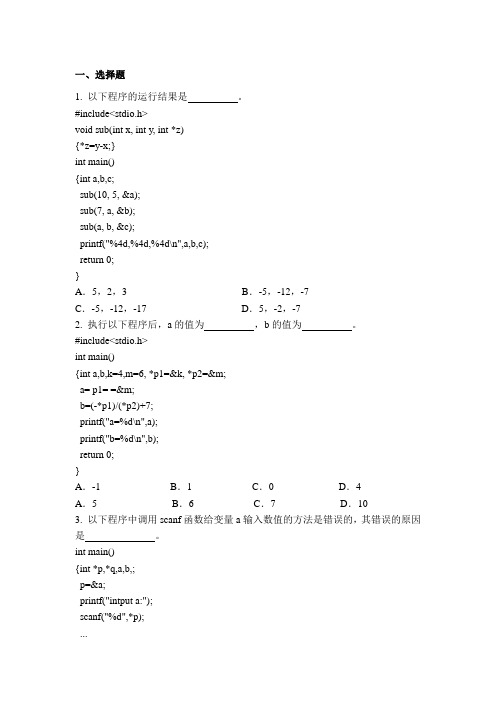
一、选择题1. 以下程序的运行结果是。
#include<stdio.h>void sub(int x, int y, int *z){*z=y-x;}int main(){int a,b,c;sub(10, 5, &a);sub(7, a, &b);sub(a, b, &c);printf("%4d,%4d,%4d\n",a,b,c);return 0;}A.5,2,3 B.-5,-12,-7C.-5,-12,-17 D.5,-2,-72. 执行以下程序后,a的值为,b的值为。
#include<stdio.h>int main(){int a,b,k=4,m=6, *p1=&k, *p2=&m;a= p1= =&m;b=(-*p1)/(*p2)+7;printf("a=%d\n",a);printf("b=%d\n",b);return 0;}A.-1 B.1 C.0 D.4A.5 B.6 C.7 D.103. 以下程序中调用scanf函数给变量a输入数值的方法是错误的,其错误的原因是。
int main(){int *p,*q,a,b,;p=&a;printf("intput a:");scanf("%d",*p);...}A .*p 表示的是指针变量p 的地址B .*p 表示的是变量a 的值,而不是变量a 的地址C .*p 表示的是指针变量p 的值D .*p 只能用来说明p 是一个指针变量4. 有如下语句int a=10,b=20,*p1,*p2; p1=&a; p2=&b; 如左图所示,若要实现右图所示的存储结构,可选用的赋值语句是 。
A .*p1=*p2B .p1=p2C .p1=*p2D .*p1=p25. 若需要建立如图所示的存储结构,且已有说明float *p, m=3.14; 正确的赋值语句是 。
指针经典练习题(含答案版)一
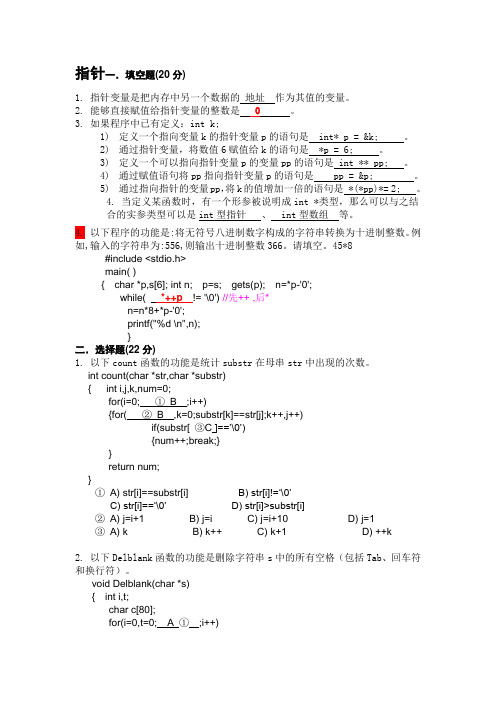
指针一.填空题(20分)1. 指针变量是把内存中另一个数据的地址作为其值的变量。
2. 能够直接赋值给指针变量的整数是 0。
3. 如果程序中已有定义:int k;1)定义一个指向变量k的指针变量p的语句是 int* p = &k; 。
2)通过指针变量,将数值6赋值给k的语句是 *p = 6; 。
3)定义一个可以指向指针变量p的变量pp的语句是 int ** pp; 。
4)通过赋值语句将pp指向指针变量p的语句是 pp = &p; 。
5)通过指向指针的变量pp,将k的值增加一倍的语句是 *(*pp)*= 2; 。
4. 当定义某函数时,有一个形参被说明成int *类型,那么可以与之结合的实参类型可以是int型指针、 int型数组等。
4. 以下程序的功能是:将无符号八进制数字构成的字符串转换为十进制整数。
例如,输入的字符串为:556,则输出十进制整数366。
请填空。
45*8#include <stdio.h>main( ){ char *p,s[6]; int n; p=s; gets(p); n=*p-'0';while( *++p != '\0') //先++ ,后*n=n*8+*p-'0';printf("%d \n",n);}二.选择题(22分)1. 以下count函数的功能是统计substr在母串str中出现的次数。
int count(char *str,char *substr){ int i,j,k,num=0;for(i=0; ①B ;i++){for( ②B ,k=0;substr[k]==str[j];k++,j++)if(substr[ ③C ]==’\0’){num++;break;}}return num;}①A) str[i]==substr[i] B) str[i]!=‘\0’C) str[i]==‘\0’ D) str[i]>substr[i]②A) j=i+1 B) j=i C) j=i+10 D) j=1③A) k B) k++ C) k+1 D) ++k2. 以下Delblank函数的功能是删除字符串s中的所有空格(包括Tab、回车符和换行符)。
C语言指针习题及答案
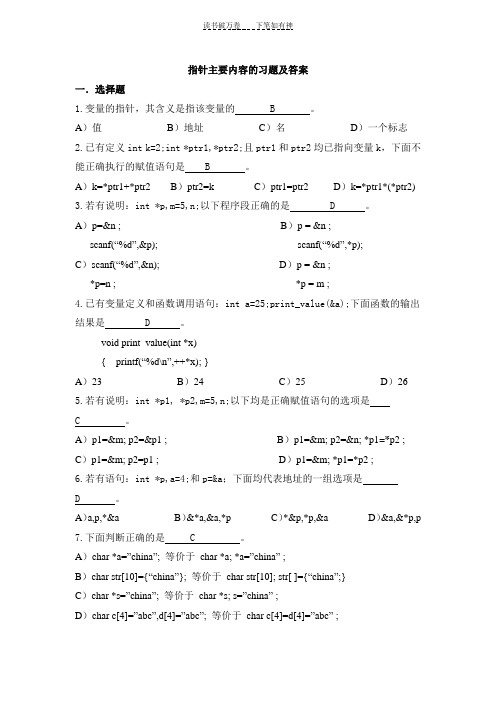
指针主要内容的习题及答案一.选择题1.变量的指针,其含义是指该变量的 B 。
A)值B)地址C)名D)一个标志2.已有定义int k=2;int *ptr1,*ptr2;且ptr1和ptr2均已指向变量k,下面不能正确执行的赋值语句是 B 。
A)k=*ptr1+*ptr2 B)ptr2=k C)ptr1=ptr2 D)k=*ptr1*(*ptr2) 3.若有说明:int *p,m=5,n;以下程序段正确的是 D 。
A)p=&n ; B)p = &n ;scanf(“%d”,&p); scanf(“%d”,*p);C)scanf(“%d”,&n); D)p = &n ;*p=n ; *p = m ;4.已有变量定义和函数调用语句:int a=25;print_value(&a);下面函数的输出结果是 D 。
void print_value(int *x){ printf(“%d\n”,++*x); }A)23 B)24 C)25 D)265.若有说明:int *p1, *p2,m=5,n;以下均是正确赋值语句的选项是C 。
A)p1=&m; p2=&p1 ; B)p1=&m; p2=&n; *p1=*p2 ; C)p1=&m; p2=p1 ; D)p1=&m; *p1=*p2 ;6.若有语句:int *p,a=4;和p=&a;下面均代表地址的一组选项是D 。
A)a,p,*&a B)&*a,&a,*p C)*&p,*p,&a D)&a,&*p,p 7.下面判断正确的是 C 。
A)char *a=”china”; 等价于char *a; *a=”china” ;B)char str[10]={“china”}; 等价于char str[10]; str[ ]={“china”;}C)char *s=”china”; 等价于char *s; s=”china” ;D)char c[4]=”abc”,d[4]=”abc”; 等价于char c[4]=d[4]=”abc” ;8.下面程序段中,for循环的执行次数是 C 。
- 1、下载文档前请自行甄别文档内容的完整性,平台不提供额外的编辑、内容补充、找答案等附加服务。
- 2、"仅部分预览"的文档,不可在线预览部分如存在完整性等问题,可反馈申请退款(可完整预览的文档不适用该条件!)。
- 3、如文档侵犯您的权益,请联系客服反馈,我们会尽快为您处理(人工客服工作时间:9:00-18:30)。
一、用指针方法编写一个程序,输入3个整数,将它们按由小到大的顺序输出#include <stdio.h>void swap(int *pa,int *pb){int temp;temp = *pa;*pa = *pb;*pb = temp;}void main(){int a,b,c,temp;scanf("%d%d%d",&a,&b,&c);if(a>b)swap(&a,&b);if(b>c)swap(&b,&c);if(a>c)swap(&a,&c);printf("%d,%d,%d",a,b,c);}二、C语言用指针方法输入3个字符串按由小到大顺序输出#include "stdio.h"#include "string.h"int main(int argc, char* argv[]){char *t;char *p1=NULL,*p2=NULL,*p3=NULL;char ch1[20]={0},ch2[20]={0},ch3[20]={0};p1=ch1;p2=ch2;p3=ch3;printf("No1:");scanf("%s",p1);fflush(stdin);printf("No2:");scanf("%s",p2);fflush(stdin);printf("No3:");scanf("%s",p3);fflush(stdin);if(strcmp(p1,p2)>0){t=p1;p1=p2;p2=t;}if(strcmp(p1,p3)>0){t=p1;p1=p3;p3=t;}if(strcmp(p2,p3)>0){t=p2;p2=p3;p3=t;}printf("%s\n%s\n%s\n",p1,p2,p3);return 0;}9.4编程输入一行文字,找出其中的大写字母,小写字母,空格,数字,及其他字符的个数#include<stdio.h>void main(){int a=0,b=0,c=0,d=0,e=0,i=0;char *p,s[20];while((s[i]=getchar())!='\n')i++;p=s;while(*p!=10){if(*p>='A'&&*p<='Z')a++;else if(*p>='a'&&*p<='z')b++;else if(*p==' ')c++;else if(*p>='0'&&*p<='9')d++;else e++;p++;}printf("大写字母%d 小写字母%d\n",a,b);printf("空格 %d 数字 %d 非字符 %d\n",c,d,e);}9.5写一个函数,将3 3矩阵转置#include "stdio.h"void Transpose(int (*matrix)[3]){int temp;int i, j;for(i=1;i<3;i++)/*转置*/{for(j=0;j<i;j++){temp = *(*(matrix+j)+i);*(*(matrix+j)+i) = *(*(matrix+i)+j);*(*(matrix+i)+j) = temp;}}}void main(){int a[3][3] = {{1,2,3},{4,5,6},{7,8,9}};Transpose(a);for(int i = 0;i<3;i++){for(int j=0;j<3;j++){printf("%d ",a[i][j]);}printf("\n");}}}9.6用指向一维数组的指针做函数参数#include<stdio.h>#include<string.h>int main(){void sort(char (*s)[6]);//一维数组的指针做函数参数int i;char str[10][6];char (*p)[6];//定义一维数组的指针做函数参数printf("please input string:/n");for(i=0;i<10;i++)scanf("%s",&str[i]);p=str;//将str一维数组指针,赋值给p;sort(p);printf("the output sequence :/n");for(i=0;i<10;i++)printf("%s/n",str[i]);return 0;}void sort(char (*s)[6])//s指向一维数组的指针做函数参数;{int i,j;char temp[6], *t;t=temp;for(i=0;i<9;i++)//i应该小于9;如果小于10,那么就比较了9+1次;按照冒泡法则,for(j=0;j<9-i;j++)//第一次比较需要9次就是i=0到i=8共九次;第二次需要比较8次;依次类推;if(strcmp(s[j],s[j+1])>0){strcpy(t,s[j]);strcpy(s[j],s[j+1]);strcpy(s[j+1],t);}}9.7编一程序,用指针数组在主函数中输入十个等长的字符串。
用另一函数对它们排序,然后在主函数中输出10个已排好序的字符串//用指针数组处理#include<stdio.h>#include<string.h>int main(){void sort(char *[]);int i;char str[10][6], *p[10];printf("please input 10 string:/n");for(i=0;i<10;i++)//首先将10个str的首地址赋值给10个p[i];p[i]=str[i];//将第i个字符串的首地址赋予指针数组p的第i个元素;for(i=0;i<10;i++)scanf("%s",p[i]);//scanf输入到&p[i]sort(p);printf("the output 10 string:/n");for(i=0;i<10;i++)printf("%s/n",p[i]);//输出到p[i];}void sort(char *s[]){char *temp;int i,j;for(i=0;i<9;i++)for(j=0;j<9-i;j++)if(strcmp(*(s+j),*(s+j+1))>0){temp=*(s+j);//*(s+j)指向数组指针,我想应该是字符串的首地址;所以可以直接赋值给temp指针;*(s+j)=*(s+j+1);*(s+j+1)=temp;}}9.8指针将n个数按输入时顺序的逆序排列,用函数实现#include <stdio.h>void reverse(int a[],int n){ int *p;for(p=a+n-1;p>=a;p--)printf("%4d",*p);printf("\n");}main(){ int a[20],n;int i;printf("Input the length of array:");scanf("%d",&n);printf("Input the number of array:");for(i=0;i<n;i++)scanf("%d",&a[i]);reverse(a,n);}9.9写一函数,实现两个字符串的比较。
即自己写一个strcmp函数,函数原型为:int stremp(char *p1,char *p2)设p1指向字符串s1,p2指向字符串s2。
要求:当s1=s2时,返回值为0。
当s1不等于s2时,返回它们二者的第一个不同字符的ASCII码差值(如“BOY”与“BAD”,第二字母不同,“O”与“A”之差为79-65=14);如果s1>s2,则输出正值;如果s1<s2,则输出负值。
#include <stdio.h>main(){ int strcmp(char *p1,char *p2);int m;char str1[20],str2[20],*p1,*p2;printf("Input two strings:\n");scanf("%s",str1);scanf("%s",str2);p1=&str1[0];p2=&str2[0];m=strcmp(p1,p2);printf("result: %d\n",m);}int strcmp(char *p1,char *p2) /*两个字符串比较的函数*/ { int i;i=0;while(*(p1+i)==*(p2+i))if(*(p1+i++)=='\0') return(0); /*相等时返回结果0*/return(*(p1+i)-*(p2+i)); /*不等时返回结果为第一个不等字符ASCII码的差值*/}运行情况如下:① Input two strings:CHINA↙Chen↙Result: -32② Input two strings:hello! ↙Hello! ↙Result: 0③ Input two stings:dog↙cat↙result: 19.10编一个程序,打入月份号,输出该月的英文月名。
例如,输入“3”,则输出“March”,要求用指针数组处理。
#include <stdio.h>main(){ char *month_name[13]={"illegalmonth","January","February","March","April","May","June","July","August","September","October","November","D ecember"};int n;printf("Input month: ");scanf("%d",&n);if((n<=12)&&(n>=1))printf("It is %s.\n",*(month_name+n));elseprintf("It is wrong.\n");}运行结果:① Input month: 2↙It is February.② Input month: 8↙It is August.③ Input month: 13↙It is wrong.9.11c语言:将字符串computer赋给一个字符数组,然后从第一个字母开始间隔地输出该串。
